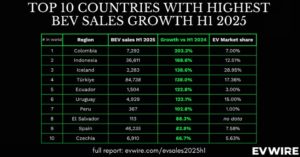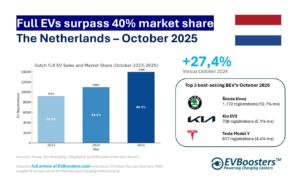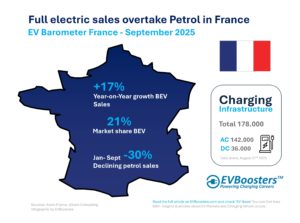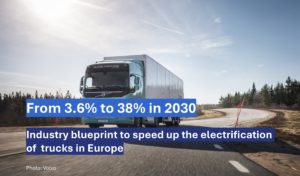Understanding the 2025 CO2 targets
Starting in 2025, the EU’s CO2 targets aim for an average reduction of 15% in emissions from new passenger cars, compared to levels in 2021. This means that the fleet-wide target for CO2 emissions will drop to 93,6 grams per kilometer, as measured by the Worldwide Harmonised Light Vehicles Test Procedure (WLTP). Automakers will need to make steady progress, reducing their fleet’s emissions by about 4% each year between 2021 and 2025.
On average, the ICCT report estimates that carmakers will have to cut emissions by 12% from their 2023 levels to hit the 2025 targets. But not all manufacturers face the same challenge. Some, like Volvo, are close to meeting the new standards already. Others, such as Volkswagen and Ford, will need to reduce their fleet emissions by up to 21% to comply.
Powertrain mix in 2023: The starting point
In 2023, European roads featured a mix of internal combustion engine vehicles (ICEVs), plug-in hybrid electric vehicles (PHEVs), and battery electric vehicles (BEVs). While BEVs have grown in popularity, they still made up a relatively small share of new car registrations. Automakers like Volvo, which has leaned heavily into electric models, are better positioned to meet the 2025 targets. But others, including Ford and Volkswagen, face a steeper climb, needing to significantly ramp up their production and sale of electric cars.
The role of electric vehicles in meeting the targets
One key strategy for manufacturers is increasing the share of BEVs in their fleets. If automakers rely solely on this approach, they will need to boost their BEV market share substantially. The ICCT report suggests that some companies may need to increase their BEV shares by as much as 8 to 18 percentage points compared to 2023 levels.
For instance, Ford and Volkswagen face some of the steepest increases, needing to boost their BEV shares by around 17 to 18 percentage points. Others, like BMW and Kia, have a bit more breathing room but will still need to increase their electric vehicle sales by about 8 to 9 percentage points to hit the 2025 targets.
Pooling: A path to compliance
The EU’s CO2 rules include a pooling mechanism, allowing manufacturers to combine their fleets to meet emission standards collectively. This means that companies with higher emissions can team up with those that are ahead on CO2 reductions, balancing out their overall targets.
The ICCT analysis explores possible pooling scenarios, including partnerships between Volkswagen and Tesla or Toyota and Renault-Nissan-Mitsubishi. These alliances could significantly reduce the effort needed to meet the 2025 goals. For example, a potential pool between Volvo and Ford could cut their required CO2 reduction down to just 6%, while other pools might bring the required reduction closer to the fleet-wide average of 12%.
Pooling could also ease the need for higher BEV market shares. For the hypothetical groups considered, the increase in BEV shares could drop to between 4 and 12 percentage points—making the targets more manageable for manufacturers.
Learning from past successes
This isn’t the first time the auto industry has faced new emission targets. Between 2019 and 2021, EU regulations required manufacturers to reduce their CO2 output by 23%. During that period, automakers managed to boost their BEV market share by about 8 percentage points, despite a less developed charging network and a limited selection of electric models.
The ICCT suggests that, based on this past performance, achieving a 12 percentage point increase in BEV shares from 2023 to 2025 is within reach. Today, the landscape is more favourable, with a broader range of BEV options, improved charging infrastructure, and growing consumer interest in electric cars.
Other paths to compliance
While expanding BEV sales is a primary strategy, it’s not the only option for meeting the new targets. Manufacturers can also focus on improving the efficiency of their ICEVs. This could mean shifting sales strategies towards lighter, more fuel-efficient models or adopting mild hybrid technologies that can cut CO2 emissions by 7% to 15%.
Additionally, plug-in hybrid electric vehicles (PHEVs) could play a role, especially those with extended electric ranges. However, changes in how PHEV emissions are calculated from 2025 mean that their effectiveness for compliance will diminish. The new calculations will more accurately reflect real-world driving conditions, making it harder for automakers to rely on PHEVs to reduce fleet emissions on paper.
A turning point for the industry
The ICCT’s findings suggest that the industry faces a challenging but achievable path to meeting the 2025 targets. Manufacturers need to quickly adapt their product lines and sales strategies to increase the presence of electric vehicles. At the same time, strategic pooling arrangements and improving the efficiency of existing ICEV models could provide additional routes to compliance.
The experience from the last round of CO2 reductions in 2019-2021 shows that carmakers can adapt swiftly when faced with regulatory pressure. While the challenge is significant, the push towards a cleaner, more sustainable automotive future aligns with broader market trends and consumer demand.
Looking ahead
The new targets come at a time when the transition to electric vehicles is gaining momentum globally. For European automakers, the 2025 CO2 targets represent not only a regulatory hurdle but also an opportunity to solidify their place in a market that increasingly values sustainability. Success will require a mix of innovation, strategic partnerships, and a commitment to greener technologies.
As the clock ticks down to 2025, the race is on. Car manufacturers have proven they can adapt quickly, and this time, the stakes are even higher—not just for compliance but for leadership in the rapidly changing automotive industry.
Source: The ICCT







